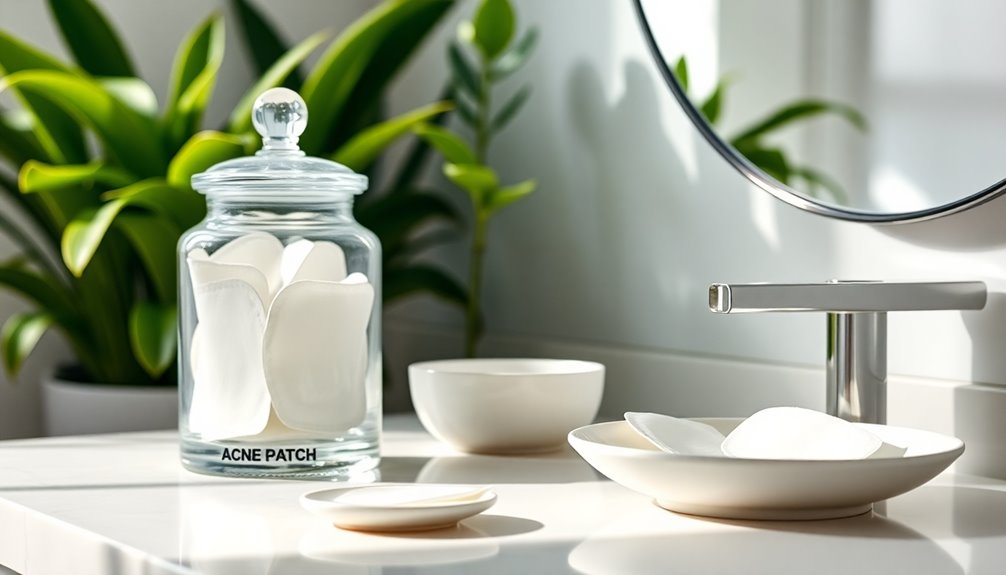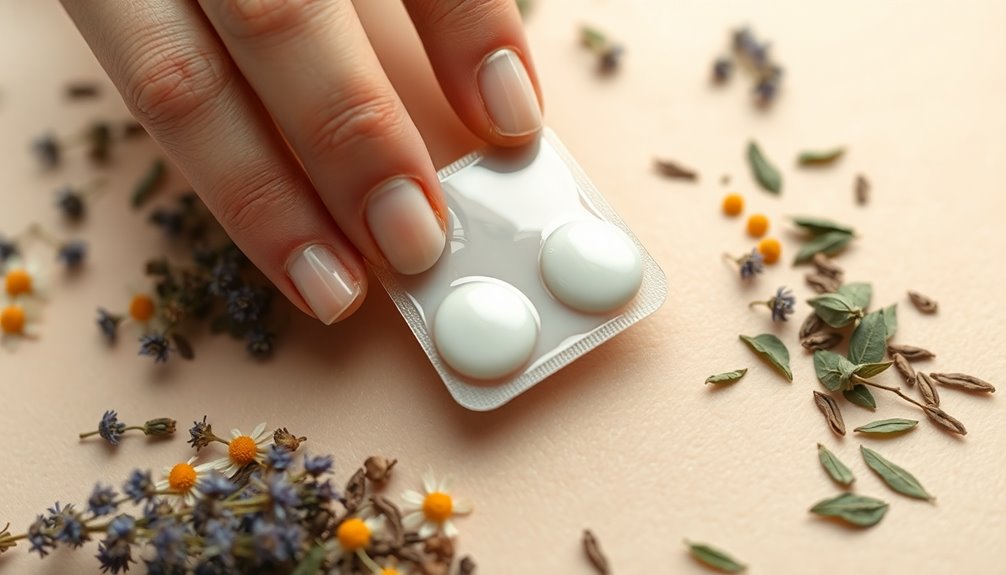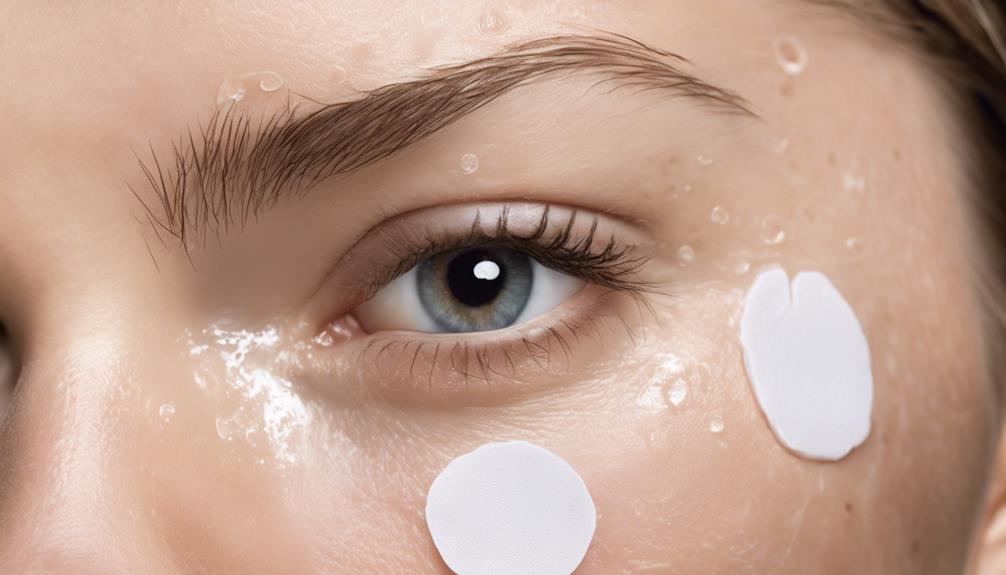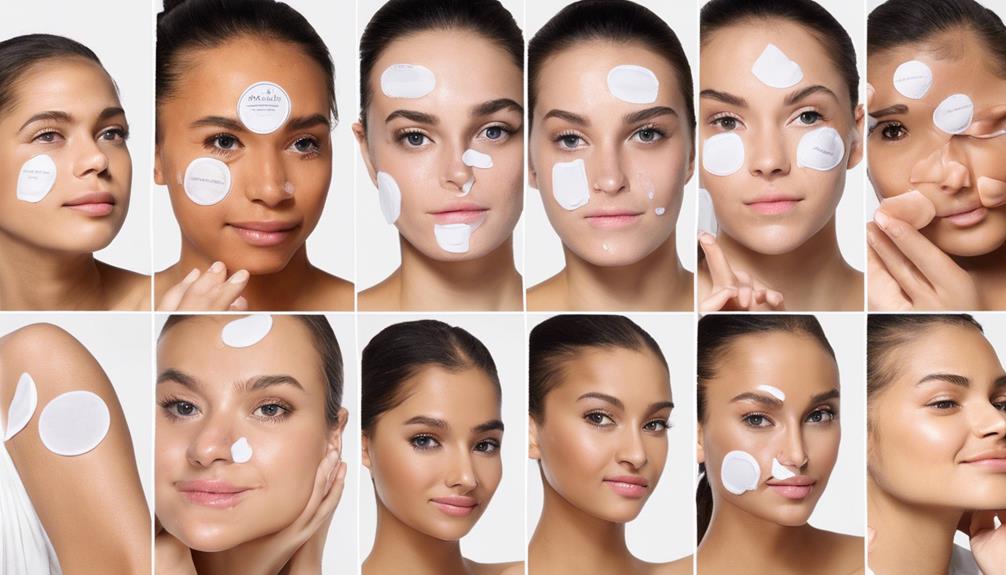Yes, acne patches are safe for daily use, especially for treating surface-level breakouts. They help absorb excess fluid, promote healing, and create a protective barrier that minimizes scarring. Just be sure to apply them on clean, dry skin and monitor for any irritation. If you're new to using patches or have sensitive skin, start slowly to see how your skin reacts. There's a lot more to learn about optimizing your patch usage and skincare routine.
Key Takeaways
- Acne patches can be used daily to effectively target emerging breakouts and promote healing.
- They create a protective barrier, minimizing scarring and reducing inflammation.
- Daily application is generally safe, depending on individual skin type and breakout severity.
- Monitor for signs of dryness or irritation, especially with sensitive skin.
- Pairing patches with a good moisturizer helps maintain skin hydration and overall health.
Understanding Acne Patches

When you're dealing with a breakout, acne patches can be a game-changer. These pimple patches are adhesive stickers that you apply directly to your pimples, promoting healing and preventing the urge to pick.
Made from hydrocolloid material, they absorb excess fluid while creating a moist environment that helps your skin heal faster. Acne patches come in various sizes and thicknesses, making them perfect for targeted treatment without drawing attention.
Many contain active ingredients like salicylic acid and tea tree oil, which work to reduce inflammation and kill acne-causing bacteria. Hydrocolloid technology promotes healing by drawing out impurities and is recommended by dermatologists for localized treatment.
While pimple patches are effective for surface-level breakouts, they don't tackle deeper types of acne or underlying causes, so use them alongside a regular skincare routine, especially if you have sensitive skin.
Benefits of Daily Use

Using acne patches daily can greatly boost your skincare routine. By applying pimple patches at the first sign of acne, you effectively target emerging breakouts with timely treatment.
These patches create a protective barrier, preventing you from picking at pimples, which minimizes scarring and promotes faster healing. Many patches contain active ingredients like salicylic acid and tea tree oil, which reduce inflammation and unclog pores, making them ideal for daily use. Additionally, combining patches with glycolic acid can enhance skin texture and tone, leading to clearer skin over time.
Pimple patches form a protective barrier, reducing scarring and promoting healing while containing ingredients that soothe inflammation and unclog pores.
Regular application enhances the effectiveness of your overall skincare routine, complementing cleansing and moisturizing practices. Just remember to hydrate with a suitable moisturizer, especially if you have sensitive skin types, to prevent dryness or irritation.
Enjoy the benefits of clearer skin by incorporating pimple patches into your daily regimen!
How to Use Pimple Patches Effectively

To get the most out of pimple patches, start by cleansing your face thoroughly and ensuring the affected area is completely dry. This helps maximize adhesion and effectiveness.
Choose a patch that's appropriately sized, covering the pimple without overlapping onto the surrounding skin to avoid irritation. Apply a pimple patch and leave it on for at least six hours, ideally up to twelve, until it turns white, indicating it's absorbed fluids. Using effective pimple patches can enhance the results, particularly those designed for stubborn cystic acne.
After removing the patch, gently cleanse the area to eliminate any residue. Follow up with a spot treatment and a hydrating moisturizer to support healing.
Finally, monitor your skin for any signs of irritation or redness, and adjust usage frequency or patch type accordingly.
Considerations for Sensitive Skin

If you have sensitive skin, it's important to approach acne patches with caution.
While pimple patches can be effective, they might cause irritation if used too frequently. Start with intermittent use to gauge how your skin reacts before considering daily application.
Monitor for signs of redness or discomfort; if they occur, it's best to stop using the patches immediately.
Incorporating a soothing moisturizer, like tbh thirst trap, can help combat potential dryness and irritation caused by the patches.
If irritation persists, consulting a dermatologist is wise to explore alternative treatment options. Additionally, be mindful of potential side effects associated with prolonged use of topical treatments.
Taking these precautions can help you safely integrate acne patches into your skincare routine without compromising your sensitive skin.
Recommended Frequency of Use

You can use pimple patches every day if you need to, but how often you apply them depends on your skin type and breakout severity. It's essential to watch for any dryness or irritation, especially if you have sensitive skin. Pairing patches with a good moisturizer can help keep your skin hydrated and comfortable during treatment. Additionally, using patches can be part of a larger skincare routine, which 60% of consumers follow daily, emphasizing the importance of consistent care.
Daily Usage Guidelines
While daily use of pimple patches is generally safe and effective, the frequency can vary based on your skin type and the severity of your breakouts. You can apply pimple patches at the first sign of a breakout, but it's important to listen to your skin.
If you have sensitive skin, you might experience dryness or irritation, so keep an eye on how your skin responds. To maintain a moisturized environment, consider using a hydrating moisturizer, like tbh thirst trap, alongside the patches. Additionally, incorporating positive reinforcement techniques in your skincare routine can help you achieve better results.
Skin Type Considerations
Understanding your skin type is key to determining how often you should use acne patches. If you have sensitive skin, daily use might lead to dryness or irritation.
It's important to pay attention to how your skin reacts and adjust your frequency accordingly. For most skin types, using acne patches at the first sign of a breakout is effective, but if you notice any discomfort, consider reducing how often you apply them.
Remember, while you can use patches as needed, they shouldn't be kept on if they become loose or cause irritation.
Regularly cleansing your face also helps maintain overall skin health, especially when using patches, so guarantee your skin stays free from excess oils and impurities. Additionally, maintaining hydration levels is crucial for skin health and can enhance the effectiveness of acne treatments.
Moisturizer Importance
Moisturizer plays an essential role in your skincare routine, especially when using acne patches. It helps prevent dryness and irritation, which is vital for sensitive skin.
To maintain hydration without clogging pores, consider a lightweight, non-comedogenic moisturizer like tbh thirst trap. Regularly using a moisturizer supports your skin barrier, particularly when you apply patches daily, promoting overall skin health.
After removing a pimple patch, gently wash your face and follow up with moisturizer to soothe your skin and provide necessary hydration. Additionally, incorporating products with glycolic acid can enhance your skin's texture and help with acne treatment.
For best results, incorporate a moisturizer into your daily skincare routine alongside pimple patches. This combination enhances the effectiveness of your acne treatment while keeping your skin balanced and healthy.
What to Expect When Using Pimple Patches

Curious about what happens when you use pimple patches? When you notice a breakout, apply a pimple patch on the affected area. Wear it for at least six hours, but ideally up to twelve for the best results. After removing the patch, use a gentle cleanser to remove any residue, then apply a spot treatment on active breakouts. Finally, don't forget to hydrate your skin with a moisturizer.
Here's a quick overview of what to expect:
| Action | Result |
|---|---|
| Apply patch | Targets breakout |
| Wear for 6-12 hours | Maximizes effectiveness |
| Monitor for irritation | Guarantee no redness or irritation occurs |
With daily use, keep an eye on your skin for any signs of irritation or redness. Additionally, ensure you are using a gentle formula, as harsh chemicals may irritate the skin.
Aftercare Following Patch Removal

After you remove a pimple patch, make sure to wash your face gently with an anti-bacterial cleanser to get rid of any residue.
Next, apply a spot treatment to any active breakouts for extra support.
Don't forget to moisturize and protect your skin afterward to keep it healthy and hydrated. Additionally, maintaining a balanced diet rich in vitamins, minerals, and antioxidants can also support your skin's healing process.
Cleanse Residue Thoroughly
Once you've removed the pimple patch, it's crucial to cleanse your face thoroughly to prevent irritation.
Residue from the patch can clog pores and lead to breakouts if left unaddressed. Use an anti-bacterial cleanser to effectively cleanse away any leftover adhesive and fluid.
Afterward, you can follow up with your favorite moisturizer to keep your skin hydrated.
Consider these steps:
- Use a gentle anti-bacterial cleanser.
- Verify all residue from the patch is removed.
- Pat your face dry instead of rubbing.
- Apply a moisturizer to maintain hydration.
- Consider using a serum to support healing.
Apply Spot Treatment
Having cleansed your face thoroughly, it's time to focus on spot treatment for those lingering breakouts.
After removing the pimple patches, use an anti-bacterial cleanser to eliminate any residue and prevent infection.
Once your skin's clean, apply a targeted spot treatment, like an acne hack cream, to address active breakouts and reduce inflammation.
This step is essential, especially for acne-prone skin, as it promotes healing.
Don't forget to follow up with a moisturizer to maintain hydration and avoid dryness.
If you're feeling extra cautious, a rebound serum can help support your skin barrier after patch use.
This routine can enhance recovery and keep your skin looking its best!
Moisturize and Protect
To guarantee your skin recovers effectively after removing acne patches, start by gently cleansing your face with an antibacterial cleanser. This helps eliminate any residue and prevents infection.
Next, focus on moisturizing and protecting your skin:
- Apply a hydrating moisturizer, like tbh thirst trap, to replenish moisture lost during patch wear.
- Use a rebound serum to enhance hydration and support your skin barrier.
- Consider a targeted acne hack cream as a spot treatment for remaining breakouts.
- Always apply a broad-spectrum SPF50+ sunscreen to shield your skin, especially if it's sensitive post-patch removal.
- Reapply sunscreen throughout the day to maintain protection.
Following these steps guarantees your skin stays healthy and hydrated after using acne patches.
Alternative Acne Treatments

When it comes to treating acne, a variety of alternative treatments can effectively target your skin concerns.
Topical retinoids promote cell turnover and prevent clogged pores, making them suitable for severe cases. Benzoyl peroxide is another strong option; it acts as an antiseptic to kill bacteria and reduce inflammation, commonly found in over-the-counter skincare products.
For mild to moderate acne, salicylic acid helps exfoliate the skin and unclog pores. If you prefer natural remedies, tea tree oil boasts antibacterial properties, though it might irritate sensitive skin.
Additionally, oral medications like antibiotics or hormonal treatments can be effective for managing acne related to hormonal fluctuations.
Always consult with a healthcare professional to find the best alternative acne treatments for you.
Frequently Asked Questions
Do Dermatologists Recommend Pimple Patches?
Yes, dermatologists often recommend pimple patches for treating isolated breakouts.
They see these patches as a convenient way to manage acne without risking scarring from picking. By applying them at the first sign of a pimple, you can help speed up healing.
However, while they're effective for surface-level acne, dermatologists advise you to also maintain a complete skincare routine for better results and to monitor your skin's response for any irritation.
Can You Overuse Pimple Patches?
Using pimple patches too often can be like watering a plant too much—they can suffocate your skin instead of helping it.
You can definitely overuse them, especially if you have sensitive skin. While it's okay to apply them daily, pay attention to any irritation or dryness.
Always remove patches when they turn white, and don't reuse them.
Keeping a balanced skincare routine will help prevent any negative effects from frequent use.
Can You Use Acne Spot Treatment Everyday?
Yes, you can use acne spot treatment every day if needed, especially when you notice a breakout starting.
Just keep an eye on how your skin reacts, as daily use might lead to dryness or irritation, particularly for sensitive skin.
It's important to maintain a complete skincare routine, including cleansing and moisturizing, to support your skin.
Consider incorporating a good moisturizer to help counteract any dryness from frequent treatment application.
What Are the Disadvantages of Acne Patches?
Imagine relying on a magic shield to guard you against acne. While acne patches can be helpful, they're not without pitfalls.
They might dry out your skin or irritate it, especially if you're sensitive. Plus, they won't tackle clogged pores or stubborn cystic acne.
Overusing them may make you forget other key skincare steps, and your skin might get too accustomed to the patches, reducing their effectiveness.
Balance is key in your skincare journey!
Conclusion
In a world brimming with skincare miracles, acne patches stand out like a beacon of hope! They're not just safe for daily use; they're like your skin's secret weapon against pesky pimples. With the right application and a little love for your skin, you'll be amazed at how quickly those blemishes fade away. So go ahead, embrace the patch life, and watch your confidence soar as you reveal your radiant, clear complexion! It's like magic in a tiny square!
Claire has a knack for turning complex dermatological concepts into engaging, easy-to-understand articles. Her work primarily focuses on creating detailed reviews and thought-provoking articles in the “Vetted” category. Claire’s writing not only informs but also inspires our community to try new skincare solutions.










